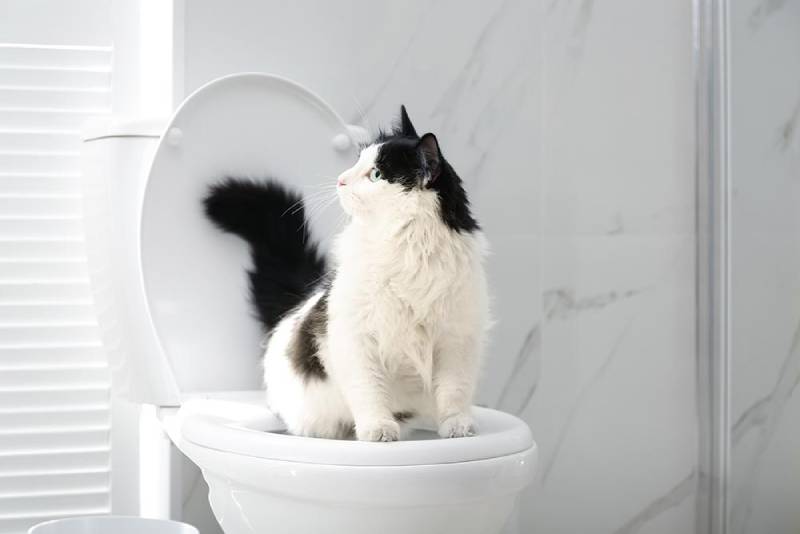Don't Flush Cat Poop Down Your Toilet - Maintain Your Home's Plumbing Integrity
Don't Flush Cat Poop Down Your Toilet - Maintain Your Home's Plumbing Integrity
Blog Article
We've stumbled on this post pertaining to Can You Flush Cat Poo or Litter Down the Toilet? below on the internet and felt it made sense to relate it with you over here.

Intro
As pet cat proprietors, it's important to be mindful of how we deal with our feline pals' waste. While it may appear practical to flush cat poop down the commode, this method can have harmful effects for both the atmosphere and human health.
Alternatives to Flushing
The good news is, there are much safer and more liable ways to take care of feline poop. Take into consideration the following options:
1. Scoop and Dispose in Trash
The most usual technique of dealing with cat poop is to scoop it into a naturally degradable bag and throw it in the garbage. Make sure to make use of a committed trash scoop and take care of the waste promptly.
2. Usage Biodegradable Litter
Select eco-friendly pet cat trash made from products such as corn or wheat. These litters are environmentally friendly and can be safely thrown away in the garbage.
3. Bury in the Yard
If you have a lawn, think about burying cat waste in a marked location away from vegetable yards and water resources. Be sure to dig deep enough to stop contamination of groundwater.
4. Set Up a Pet Waste Disposal System
Invest in a pet garbage disposal system particularly designed for feline waste. These systems use enzymes to break down the waste, lowering odor and ecological impact.
Wellness Risks
In addition to ecological concerns, flushing pet cat waste can also present wellness risks to people. Pet cat feces may include Toxoplasma gondii, a bloodsucker that can cause toxoplasmosis-- a potentially serious health problem, specifically for pregnant women and individuals with weakened immune systems.
Environmental Impact
Flushing feline poop introduces dangerous virus and bloodsuckers right into the water system, posturing a substantial danger to marine communities. These pollutants can adversely affect aquatic life and compromise water high quality.
Verdict
Liable pet dog ownership expands past offering food and shelter-- it also involves proper waste management. By avoiding purging cat poop down the commode and choosing different disposal techniques, we can decrease our environmental impact and protect human health and wellness.
Why Can’t I Flush Cat Poop?
It Spreads a Parasite
Cats are frequently infected with a parasite called toxoplasma gondii. The parasite causes an infection called toxoplasmosis. It is usually harmless to cats. The parasite only uses cat poop as a host for its eggs. Otherwise, the cat’s immune system usually keeps the infection at low enough levels to maintain its own health. But it does not stop the develop of eggs. These eggs are tiny and surprisingly tough. They may survive for a year before they begin to grow. But that’s the problem.
Our wastewater system is not designed to deal with toxoplasmosis eggs. Instead, most eggs will flush from your toilet into sewers and wastewater management plants. After the sewage is treated for many other harmful things in it, it is typically released into local rivers, lakes, or oceans. Here, the toxoplasmosis eggs can find new hosts, including starfish, crabs, otters, and many other wildlife. For many, this is a significant risk to their health. Toxoplasmosis can also end up infecting water sources that are important for agriculture, which means our deer, pigs, and sheep can get infected too.
Is There Risk to Humans?
There can be a risk to human life from flushing cat poop down the toilet. If you do so, the parasites from your cat’s poop can end up in shellfish, game animals, or livestock. If this meat is then served raw or undercooked, the people who eat it can get sick.
In fact, according to the CDC, 40 million people in the United States are infected with toxoplasma gondii. They get it from exposure to infected seafood, or from some kind of cat poop contamination, like drinking from a stream that is contaminated or touching anything that has come into contact with cat poop. That includes just cleaning a cat litter box.
Most people who get infected with these parasites will not develop any symptoms. However, for pregnant women or for those with compromised immune systems, the parasite can cause severe health problems.
How to Handle Cat Poop
The best way to handle cat poop is actually to clean the box more often. The eggs that the parasite sheds will not become active until one to five days after the cat poops. That means that if you clean daily, you’re much less likely to come into direct contact with infectious eggs.
That said, always dispose of cat poop in the garbage and not down the toilet. Wash your hands before and after you clean the litter box, and bring the bag of poop right outside to your garbage bins.
https://trenchlesssolutionsusa.com/why-cant-i-flush-cat-poop/

I recently found that piece of writing on Don’t flush cat feces down the toilet when doing a search on the web. I beg you take the opportunity to distribute this blog if you enjoyed reading it. Thank you for your time. Visit us again soon.
Get A Free Estimate Report this page